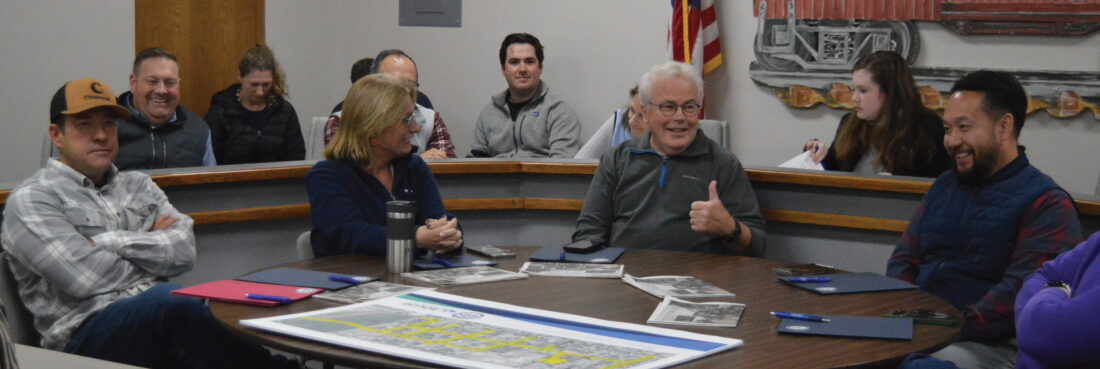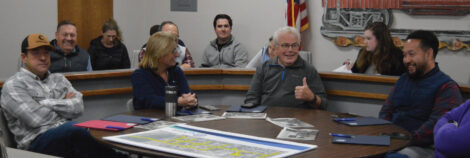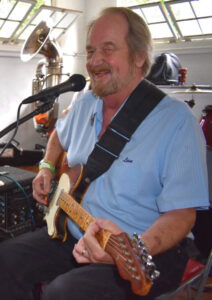Bonding requests by cities focus on water needs
SMSU seeks $55M in capital bonding for renovations

Photo by Deb Gau State Rep. Chris Swedzinski, and members of the Minnesota House Capital Investment Committee, including Rep. Mary Franson, Rep. Ned Carroll and Rep. Fue Lee, gather in the Tracy City Council chambers to hear a bonding request Wednesday.
Several area communities have the same problem: their water and sewer systems are failing, and repairs will be costly.
As a group of Minnesota state legislators toured southwest Minnesota this week, they heard a few different requests for state bonding dollars that focused on infrastructure in small cities.
Receiving a requested $7.3 million in bonding dollars would help the city of Tracy with the next phase of a project to replace century-old water and sewer lines, city officials said Wednesday.
“As a city, you can’t afford to do these kinds of projects on your own,” said Tracy Mayor Pam Cooreman.
Members of the Minnesota House Capital Investment Committee visited communities in central and southwest Minnesota this week. Stops on the tour included Southwest Minnesota State University in Marshall on Tuesday, and Tracy on Wednesday. Committee members, as well as local legislators like Rep. Chris Swedzinski and Sen. Gary Dahms, heard presentations on bonding requests from southwest Minnesota cities and SMSU.
Rep. Mary Franson, co-chair of the House Capital Investment Committee, said committee members were on their third of six tours around different regions of Minnesota, to learn about bonding requests. That information will be important as legislators work on a bonding bill.
“We’ve got to take a look and see exactly what the needs are across the state, and then you have a good visual of how that bill can get together,” Franson said.
Franson said the kinds of needs communities were bringing forward on the tours depended somewhat on the area of the state they were in.
“But water, across the state is a major concern,” she said. Small cities were facing costly repairs to their water systems, or were seeking to remove contaminants.
Water infrastructure needs
The city of Tracy was one of several area communities that presented bonding requests for water and sewer infrastructure. Tracy has been working in phases to replace aging infrastructure. In some areas, the city was replacing corroded iron pipes dating back to the early 1900s, and even clay pipes and brick manholes, said engineers from Bollig Engineering. Overall, the total cost to replace water and sewer systems was about $42 million.
The city of Tracy is asking for $7.3 million in state bonding to help with the next phase of the project, which has a cost of about $14.7 million. Laura Ostlie, of Bollig, said the city had also sought other sources of funding including Public Facilities Authority grants.
Presenters for the city of Tracy said the designs next phase of utility work were about 90% complete.
Tracy City Administrator Jeff Carpenter said Wednesday that he thought the city’s request was “very well received.” Carpenter and Cooreman said they had also presented the request to the Legislature last year.
“I think we’ve shown that we are prepared,” Carpenter said.
City officials emphasized that the next phase of construction was ready to start once funding was secured.
On Tuesday, both the cities of Russell and Ruthton also presented bonding requests to help with water and sewer improvements.
The city of Ruthton is requesting $3.9 million in state bonding for major updates to its water system. Presenters said the utility project would replace the Ruthton water tower, build a new water treatment facility, and connect the city to the Lincoln-Pipestone Rural Water System. The total project cost came to about $12 million, presenters said.
The city of Russell has been working in phases to improve its water and sewer systems, said engineers from Bollig Engineering. So far, Russell has improved its lift stations, and installed a lake overflow structure to help with flooding, said Dakota Tjaden of Bollig. But there’s still necessary work left to do.
“They’ve had a few (water main) breaks over the years. They have a lot of valves that do not work, so a lot of water shutdowns require the entire town to be shut down instead of just a block like you would typically see. A lot of hydrants do not work, as well,” Tjaden said. Tjaden said Russell also planned to improve its sanitary sewer system.
Laura Ostlie said Russell was seeking other funding sources in addition to a $4 million bonding request. That amount was the same amount as the state bonding request the city made in 2023.
Other communities, including Raymond and Sacred Heart, were also seeking bonding dollars to help with water infrastructure projects. On Tuesday, the city of Sacred Heart presented a state bonding request of $2 million to help complete upgrades like reverse osmosis water treatment at the city’s water plant, and rehab to the city water tower. Presenters said the reverse osmosis treatment would help cut back on the need for water softening, and reduce the amount of salt being released into the Minnesota River.
Facilities updates at SMSU
SMSU was also seeking about $55 million in capital bonding for a renovation project that would affect about 124,000 square feet of academic space in parts of the Bellows Academic and Physical Education buildings on campus. The project would create the SMSU Center for Rural Health and Wellness, which would include classrooms and lab space for health care-related programs.
“We know there’s a very high demand for health workers, especially in rural Minnesota,” said SMSU Associate Vice President of Advancement Nathan Polfliet. “So we know this project will have a very big impact on our ability to support our students and have them be successful in those fields.”
Director of Facilities Tony Nubile said SMSU was also seeking Higher Education Asset Preservation and Replacement (HEAPR) funding to address problems with infrastructure on the campus. Nubile said the university’s highest priority for HEAPR was to replace failing air conditioning systems in the Bellows Academic building.
“So right now, we have a $10 million request to get started with that,” he said. However, he said replacing the cooling system would allow SMSU to eliminate about $8 million of its deferred maintenance backlog.
The university was also seeking HEAPR funds for the renovation of the locker rooms in the Physical Education building, which were originally constructed in 1967.
MERIT Center seeks support for training facilities
Kim Swalboski, training facility coordinator at the Minnesota Emergency Response and Industrial Training (MERIT) Center in Marshall, said the city of Marshall was requesting bonding dollars to help build a training facility with a live burn room, and a firearms range support building at the MERIT Center.
Having access to a live burn room would give area firefighters and emergency responders a realistic option for training, Swalboski said. Currently, the closest similar facility to Marshall is about two hours away, she said.
Swalboski said the MERIT Center also hoped to be able to build a firearms range support building. The building could serve as a shelter for inclement weather, as well as a place for emergency supplies and secure storage at the firearms range, she said.



